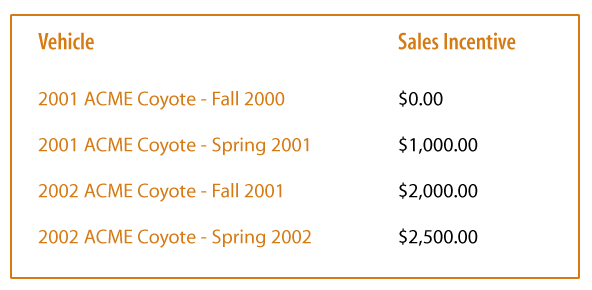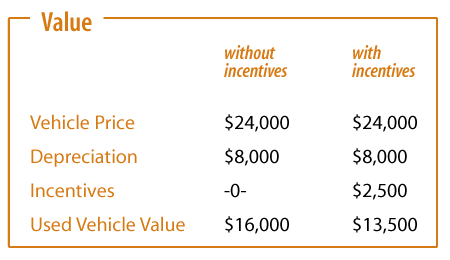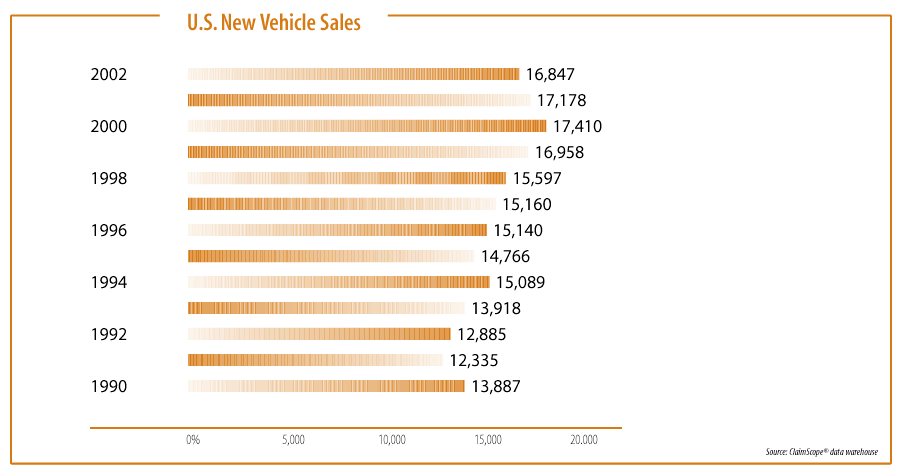
| industry insights | |
| introduction | |
| features | |
| departments/columns | |
| Industry Trends | |
| Perspective | |
| Technology | |
| Perspective | |
| CCC News Wire | |
| who we are | |
| archives | |
| CCC UpFront home |
| perspective |
| Rebate and Value |
| By Roy Stokes |
 It will come as no surprise that sales numbers for just about every industry have been on the decline over the past 24 months. A soft economy will do that. Consumers are buying fewer goods; from computers to blue jeans, money has stopped flowing like it's 1999-except when it comes to automobiles. It will come as no surprise that sales numbers for just about every industry have been on the decline over the past 24 months. A soft economy will do that. Consumers are buying fewer goods; from computers to blue jeans, money has stopped flowing like it's 1999-except when it comes to automobiles. The U.S. automotive industry dances to its own beat. Thanks in large part to marketing programs based on sales incentives, the domestic auto industry has maintained strong sales volumes for the past several years. But these incentives, while enabling domestic manufacturers to maintain sales levels, have had a negative effect on vehicle resale value. At the same time, some experts argue that these cash-back incentive programs have discouraged domestic carmakers from producing higher quality vehicles, placing them at a disadvantage to foreign competition in the long run. Let's take a closer look at these two dynamics. Lower Resale Values Take for example my own family, which recently decided we didn't want the burden of monthly payments for two newer vehicles. Our plan was to sell one of our autos- we'll call it a 2002 ACME Coyote- at a reasonable market value and replace it with an older vehicle for running around town. Our remaining newer sedan could be used for longer family trips. It seemed simple enough. It turned out to not be so simple. Instead, the process gave us an education in real world, used-vehicle pricing dynamics. In researching the resale value of our 2001 Coyote, we used the usual information sources. We consulted local used car lots and talked with sales managers to determine current selling prices for similar vehicles. We reviewed inventories of vehicles available online, in newspapers and in other print publications. In the end, we determined our vehicle was worth only about $13,500 to a retail buyer and about $10,000 on trade in. We were shocked. How could this be true for a two-year-old vehicle in great condition and an original $24,000 price tag? The answer: cash-back rebates. Cash-back incentive rebates, which were offered to buyers after we purchased our ACME Coyote, have been a major contributor to escalating depreciation. When we purchased the Coyote, dealers were not offering sales incentives. The model had been restyled and its new look had them selling like hotcakes. However, six months and a season's change later, sales had slowed. To stimulate sales, ACME began by offering a $1,000 rebate. When ACME released the 2002 Coyote, the company bumped that to $2,000 rebate. And, by the end of the 2002 calendar year, ACME was offering potential buyers a $2,500 rebate on new Coyotes, only eighteen months after we purchased our 2001 vehicle.
With these rebates, brand new Coyotes were available by 2003 for $21,500, more than ten percent less than our purchase price of $24,000, no questions asked. As a result, a potential buyer of our used ACME Coyote would scoff at paying $24,000 less depreciation. They would rightly consider the new vehicle cost of $21,500 as the benchmark from which to calculate depreciation. To make matters worse for used car sellers, depreciation percentages have begun to erode. In January 2001, used vehicles were valued at 57% of a new vehicles price, but by September 2003 the ratio had dropped to 48% of new vehicle pricingii. Historically, used vehicle pricing has been based on two factors: mileage and age. Rebates have become a powerful third force in this equation. When selling used vehicles, owners must now account for the substantially lower price of new vehicles before factoring in depreciation from mileage and age. Only then can owners begin to get an accurate perspective of their vehicle's resale value.
Quality or Quantity? When automobile sales began to lag in 2001, domestic manufacturers began implementing incentive programs, including cash rebates. These incentives originate with cash discounted by the OEMs to the dealerships, which in turn allow dealerships to sell the vehicles at a lower cost. The U.S. auto industry sought to compete on price, and it worked-for a while. But, according researchiii, U.S. market share of domestic auto manufacturers is steadily decreasing. In 1995, the market share of U.S. manufactures was 73.5 percent and by 2003 that number had hit an all-time low of 57 percent. Foreign manufacturers adopted a different strategy. While U.S. manufacturers focused on lowering vehicle price, foreign OEMs re-invested money that could have gone towards rebates and put it towards product development. They decided that short-term vehicle price was less important than long-term innovation. The cost of adding features to a new vehicle can be hundreds of dollars, far less than the thousands required to create a rebate incentive. In the short run, the incentives propped up U.S. sales and market share. However, more recently, that trend seems to be reversing, as foreign manufacturers have begun to see an increase in market share. In 1995, foreign manufactures accounted for nearly 27 percent of new car sales. In 2003, that number jumped to more than 42 percent. If this trend continues, domestic carmakers may find themselves in a precarious position. If domestic manufacturers reallocated their investments, perhaps my ACME Coyote would have the same high resale value as my neighbor's Honda Accord.
Roy Stokes is a business systems analyst at CCC Information Services Inc. i "Pulse: Global Vehicle Remarketing" report. Volume 1, 2003. Data from CNW Marketing/Research and Adesa Analytic Services. ii"Pulse: Global Vehicle Remarketing" report. Volume 1, 2003. Data from Federal Reserve Board. iii"Plunkett Research, Ltd. " US Automakers Suffer Declining Market Share," 2002 Report. Detroit News: "Incentives Depress Car Values," October 1, 2003. |


